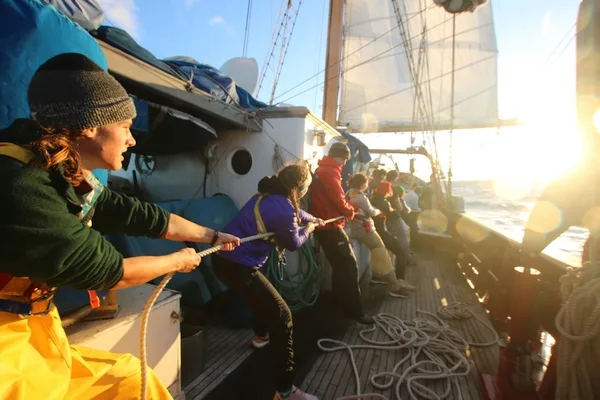News
A cornucopia of marine life

Jeff Schell, Chief Scientist
Ship’s Log
Present Location
40° 00’ N x 071° 05’ W
Ship’s Heading, Speed and sail plan
Presently Catherine is steering 228 degrees (psc) and we are sailing on a starboard tack with our four lower sails (main sail , main staysail, fore staysail and jib) full of wind making around 5 knots. Translation, we are having a lovely sail.
Weather
Clear skies, steady west wind, Beaufort Scale 4 gentle seas.
Today was special, and most onboard would say, that is an understatement. Of course memories are short. The day started off a bit rough. We were motor-sailing in some rolly, confused seas. The galley lost a bunch of eggs in one of those rolls and first sitting breakfast ‘only’ had bagels, fruit and bacon to start the day. No eggs. Rough life out here!
 Many different hands hauling on the main sail sheet
Many different hands hauling on the main sail sheet
However, come sunrise the winds and seas were starting to moderate, we set more sail, and the motion of the Cramer started to settle down…and the smiles started to emerge! The source of the smiles was not simply the change in ship motion but an important first for our voyage. We set the Main sail for the first time; that big, white, triangular sail that rises above the back half of the Cramer. She looked great in the early morning light of a rising sun, so good in fact we decided to set a few more sails, including a new, bright and shiny jib, unfurled for the very first time.
And then we fell off the edge!….and all heck broke loose….as the ol’ saying goes. Or perhaps more precisely, we happened upon the beautiful chaos that occurs in the ocean when different water masses meet at the edge of the continental shelf.
 Portuguese Man O’ War
Portuguese Man O’ War
Let me explain. Our goal for the day was to cross the shallow coastal waters of continental shelf (less than 200m deep) and explore the deeper waters of the continental slope (water depths from 200m down to 4000m). Here along the northeast coast of the US this transition into deeper water coincides with a meeting of temperate nearshore waters and tropical offshore waters associated with the Gulf Stream current. We did not reach the Gulf Stream today, but could feel its presence in the warm, salty waters and the diversity and abundance of marine life. We saw shearwaters flying by, Sargassum floating by, and ocean sunfish (Mola mola) swimming by the Cramer all day. The lab was kept busy documenting all of these observations and deploying a variety of equipment.
Afternoon Ship’s Meeting was held on deck and students learned how to double-gybe and back our jib and staysails…a sailing maneuver somewhat unique to SEA because why in the world would you want to sail so slowly… well, to tow your neuston net of course, which we did as part of our afternoon training. And to top things off a whole crowd just gathered on deck to watch the sunset. Not quite a green flash. We have to save something for another day.
Cheers
Jeff